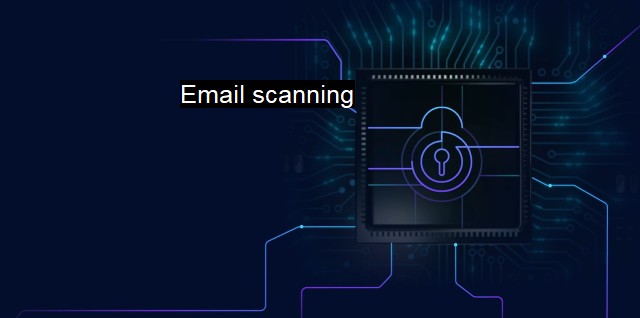What is Email scanning?
The Importance of Email Scanning: Safeguarding Your Inbox Against Cyber Threats
Email scanning is a critical aspect of cybersecurity designed to address the growing threat landscape in our digital communications. It provides an added layer of security to protect users, businesses, and organizations from various forms of cyber threats inherent in email communications. Given that email is the most convenient, fastest, and diverse means of communication employed by millions of individuals, businesses, and corporations worldwide, it has become a significant avenue for cyber attacks.Email scanning refers to the method of passing all received and sent emails through a set of cybersecurity protocols to detect malicious scripts, attempts at deception, or any content deemed inappropriate. Particularly in an organizational setting, this malware, spyware, and virus scanning provides an essential safeguard for ensuring system and data integrity while preventing unsolicited communications or dodgy digital schemes.
Advanced antivirus software often does email scanning. The software scans all incoming emails for potential threats such as viruses, Trojans, worms, ransomware, spyware, keyloggers, and many other forms of malware. With the enlisted help of signature-based detection, heuristic analysis, sandboxing, and other sophisticated tools, antivirus software can detect, isolate, and eliminate potential threats before they cause harm. The system also scans attachments and embedded links to determine if there are potential unsafe elements in them.
Email scanning extends far beyond malware detection and also keeps watch over targeted phishing attacks and business email compromise (BEC). Given that BEC scams have witnessed a massive rise email-scanning services employ advanced analytics and machine learning for fraud detection. The system scans all links, domains, and addresses connected to the emails, sniffing out the legitimacy and safeness of their sources. As such, it can effectively detect spear phishing emails programmed with deceptive language aimed at tricking the recipient into clicking on unsafe links or revealing sensitive information.
Spam filtering, which is another form of email scanning, is built into many email providers. Spam filters are designed to quarantine emails that are unsolicited, unwanted or potentially dangerous. Beyond just junk promotions and nuisance emails, spam messages can be vessels for malware spreading and phishing attacks. By using specific prescribed sets of rules or complex algorithms, the spam filter quarantines these emails into a separate location, away from your main inbox.
Importantly, email scanning can also help preserve productivity and corporate branding. For the latter, the presence of indecent, offensive, or inappropriate language can have damaging effects on workplace morale and may impact the organizational brand if such emails are forwarded to clients, customers, or competitors. Hence, cybersecurity tools also scan the content for inappropriate keywords or phrases and automatically flag them for review or deletion based on the organization’s policy.
Interception of data breaches is also a function of email scanning. In situations where highly sensitive or proprietary information gets sent out via email accidentally or intentionally, email scanning can effectively scan, detect, and stop such mails, thereby acting as the last line of defense against data leaks.
Email scanning plays a crucial role in shielding the integrity of systems and data in our highly interconnected world. Its value cannot be overstated in these times where malicious activities rage more fiercely than ever before in the cyberspace. Therefore, committing to strong email scanning practices as a part of antivirus security and preventative measures is a necessary requirement for maintaining strong cybersecurity infrastructure. The impact of negligence can result in grave consequences including financial losses, damage of reputation, and in worst cases, complete shutdown of operations. An investment in email scanning should be viewed as an investment in business continuity and prosperity, in the battle against cyber threats.

Email scanning FAQs
What is email scanning?
Email scanning is a process of examining incoming and outgoing electronic mails to identify potential threats, such as malware, spam, phishing attacks, and other malicious activities.Why is email scanning important in cybersecurity?
Emails are one of the most common gateways used by attackers to infiltrate networks, steal data, and cause damages. Email scanning can detect and stop these attacks before they cause harm, providing an essential layer of protection for organizations.How does email scanning work?
Email scanning typically involves using antivirus and antispam software that analyzes the content, attachments, links, and headers of emails. The software uses predefined rules and heuristics to determine if an email is malicious or suspicious. If it detects a threat, it can either block, quarantine, or remove the email, depending on the severity of the threat.What are some best practices for email scanning?
Some best practices for email scanning include keeping antivirus and antispam software up to date, configuring email servers to block or quarantine suspicious emails, training users to identify and report phishing attempts, and using encryption to protect sensitive data in emails. Regular monitoring and testing of email security systems can also help to identify vulnerabilities and improve the effectiveness of email scanning.| | A | | | B | | | C | | | D | | | E | | | F | | | G | | | H | | | I | | | J | | | K | | | L | | | M | |
| | N | | | O | | | P | | | Q | | | R | | | S | | | T | | | U | | | V | | | W | | | X | | | Y | | | Z | |
| | 1 | | | 2 | | | 3 | | | 4 | | | 7 | | | 8 | | |||||||